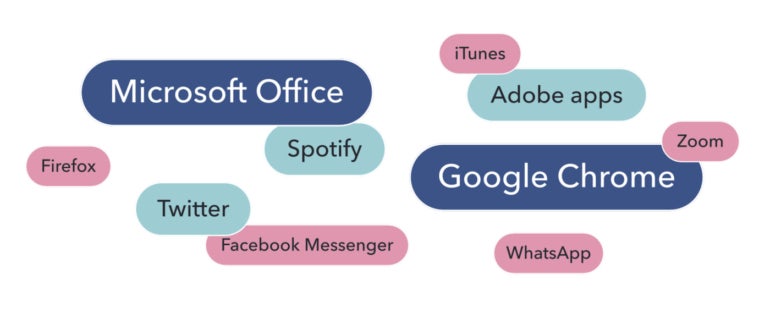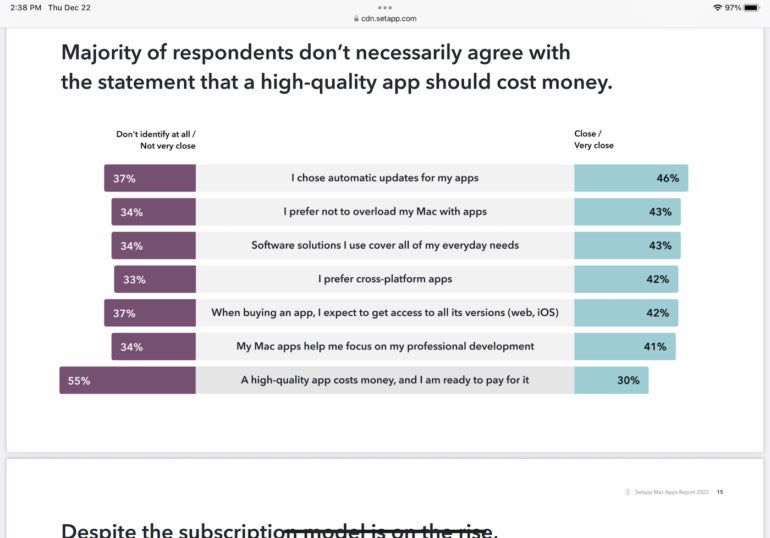[ad_1]

Professionals who use Macs in small and medium-sized businesses have intriguing software preferences, according to a new survey by Setapp Mac. Survey results from Setapp – MacPaw’s Kyiv, Ukraine-based app subscription service provider – may influence usage and purchase of Mac apps. Let’s take a look at how three changes have changed the way Mac users meet their software needs.
Jump:
Software purchasing behavior has changed
I thought choosing and buying software was pretty easy. My process for purchasing applications was simple: I identified the best option for my needs, often the market leader or its closest competitor, and purchased the appropriate license.
If original equipment manufacturer versions are available, they are usually less expensive than retail or direct purchases, but OEM licenses can usually only be used on the machine they were purchased with.
Given that I, like many users, typically have new computers within four years, this shouldn’t be a problem. After a few years, updated versions of the programs became available. Then I upgraded my edition by purchasing a new OEM license when I bought a new Mac.
Then three things happened: First, Apple launched its App Store, which made it easier to buy, track, and even update software applications; Second, Apple has redoubled its commitment to developing and maintaining easy-to-learn and impressively capable software solutions—like Mail, Messages, Pages, Numbers, and Keynote—for free on Macs; And thirdly, software signatures have been introduced and are becoming the norm in many cases.
Setapp Mac Apps Survey Says…
Where do Mac users gather information about macOS software options?
About 52% of respondents said Apple’s App Store is where they learn about Mac apps. Social media was the next most popular source at 43%, although respondents said they did not trust social media.
Instead, more than 85% of respondents trust the App Store, YouTube, podcasts, newsletters, colleagues, friends or recommendations from other professionals. I also distrust social media, favoring peer recommendations and customer feedback.
How many programs do Mac users install on their Apple computers?
According to the survey, the number of applications installed on respondents’ Macs increased from 31 in 2021 to 37 this year. However, the number of apps used daily changed only slightly: 13 compared to 12 the previous year.
See: The Complete Limited Edition Mac Bundle (TechRepublic Academy)
The fewer Mac apps you have installed, the better you can protect your device and limit the time it takes to download and install updates. The number of Mac programs you need ultimately depends on the professional responsibilities you perform and the type of work you do on a regular basis. Whenever possible, using one application for multiple purposes helps reduce the number of applications needed.
The survey also found that 10 out of 13 applications used by Mac users every day are installed by default on Macs. This finding is intriguing. Consider: More than 75% of the applications that Mac users access every day come pre-installed. The result should necessarily be a reduction in dependence on third-party software providers.
What are the most used Mac applications?
Of the native Apple apps included with macOS, the Safari web browser (68%) and the Messages app (65%) are the most used apps. This is a surprise to me – I’d bet that Mail is used more often than Messages, but maybe I’m dating myself.
Photos (59%) and Mail (57%) are the next two most used apps. After that, Calendar (47%), FaceTime (45%) and Notes (44%) are the most popular native tools (Picture a).
Picture a

When it comes to everyday office productivity software, Microsoft seems to be enjoying Word, Excel and PowerPoint.
These Microsoft Office applications, along with the Google Chrome browser and Adobe apps, are the next most frequently installed Mac applications according to Setapp’s research, as shown in the word cloud diagram. Figure B.
Figure B

What are the most important considerations for Mac users when choosing a new app?
Based on the survey, the answer is features (47%) and security (45%). The price of a Mac app (38%) and its corresponding user experience and interface (37%) are the next most important factors, followed by privacy and personal data management practices (35%). The app designer’s reputation (17%) was near the bottom, only higher than others (1%).
Many respondents believe that automatic updates (46%) and the desire not to overload Macs with unnecessary programs (43%) are important purchase considerations. About 55% of respondents feel more strongly that high-quality Mac applications are worth the money and are willing to pay the appropriate price (Figure C).
Figure C

About 42% of survey respondents say they prefer cross-platform apps. When purchasing an app, respondents prefer to get all versions, including web and iOS editions. This doesn’t surprise me: I find it simplifies licensing and software administration, especially for SMBs where multiple locations and licenses are typically at play.
When purchasing new Mac applications, the average cost a Mac user spends per year is $139. Respondents also have an average of nine paid apps on their Mac computers. Setapp notes that not all respondents differentiate between the apps they purchase and the amount they spend on in-app purchases.
While I wouldn’t expect users to have to purchase the same apps year after year, the $139 total is less than I expected. Programs I depend on, like iA Writer ($49.99 for Mac and another $49.99 for iOS and iPadOS) and Pixelmator Pro ($39.99) add up quickly.
Still, with an average purchase price of $139 for Mac apps, the typical business professional using a Mac should be able to find a budget that allows for a few reliable apps that may not need to be updated again for years—though I fear that trend is changing. .
What are Mac users’ preferences for lifetime application licenses?
I purchased the Affinity Photo Pro photo editing Mac app in August 2019 for $49.99 and thought I was all set. Imagine my surprise when I saw Affinity Photo Pro 2 hit the App Store this year for $69.99.
While it’s only fair that developers continue to get paid, I’m learning that the days of buying an app once in the App Store are over. I’ve come to terms with the fact that I just have to pay Microsoft’s annual fee to access its productivity suite, and when my professional needs require it, I do the same with Adobe’s Creative Cloud suite. That doesn’t mean other Mac users appreciate purchasing software subscriptions.
About 36% of respondents said they prefer a one-time lifetime license. Only 17% prefer annual subscriptions, monthly subscriptions are even less preferred (13%).
See: Setapp’s Mac software service confirms that app subscriptions will remain (TechRepublic)
While I no longer defer payment for a Mac app I use, this is not universally true. Setapp’s Mac apps survey confirms that Mac users are reluctant to purchase an app if the app is expensive, free alternatives are available, or they’re not sure if they should use the app regularly.
Sometimes free apps are enough, but experience has taught me that developers often put premium features like the ability to print or edit files behind a paywall. Once I find that I need a software app and it becomes necessary to perform everyday functions, I find that paying for a license makes my workflows faster and more efficient than trying to save money by using a free but limited app or doing repeated trial searches. versions.
How important is M1/M2 chip support when buying Mac apps?
The fact that Macs are increasingly powered by Apple Silicon also affects app selection. Most survey respondents indicate that it is very important (55%) or somewhat important (35%) that the Mac apps they buy boast support for the M1 and M2 chips.
Setapp’s Mac Application Research Methodology
The Setapp survey was conducted online. Over 600 US-based Mac users aged 18 and over responded. About 45% of respondents said they use a MacBook Pro, followed by MacBook Airs (34%), Mac Pros (23%), iMacs (20%), Mac minis (6%) and Mac Studios (6%) the remaining part.
[ad_2]
Source link

